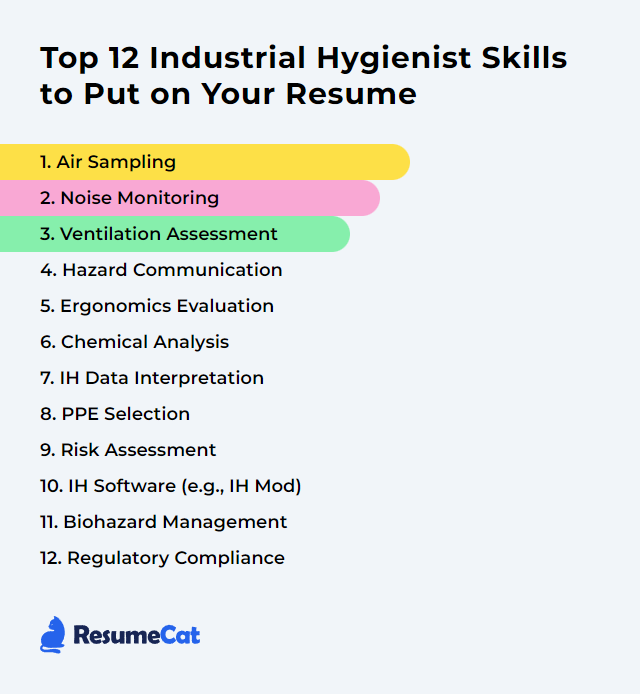Top 12 Industrial Hygienist Skills to Put on Your Resume
In the field of occupational health and safety, industrial hygienists play a crucial role in identifying and mitigating workplace hazards. A strong resume showcasing a comprehensive set of industrial hygienist skills is essential for candidates aiming to excel in this vital profession and make a significant impact on workplace safety.
Industrial Hygienist Skills
- Air Sampling
- Noise Monitoring
- Ventilation Assessment
- Hazard Communication
- Ergonomics Evaluation
- Chemical Analysis
- IH Data Interpretation
- PPE Selection
- Risk Assessment
- IH Software (e.g., IH Mod)
- Biohazard Management
- Regulatory Compliance
1. Air Sampling
Air sampling is the practice of collecting airborne contaminants to evaluate occupational exposure and verify that workplace air quality aligns with health and safety requirements.
Why It's Important
It pinpoints what workers actually breathe, quantifies exposures, and informs controls. Good sampling guards health, supports compliance, and keeps decisions rooted in evidence rather than guesswork.
How to Improve Air Sampling Skills
Match method to hazard: Use validated methods aligned to the agent, matrix, and expected concentration range. Confirm limits of detection and sampling volume are fit for purpose.
Use the right kit, calibrated right: Select proper media, flow rates, and pumps. Calibrate before and after each run with a traceable standard; document drift.
Sample where it matters: For personal sampling, stay in the breathing zone. For area sampling, place samplers at representative locations, near sources and receptor points.
Design for representativeness: Cover worst-case tasks and typical cycles. Capture enough time to reflect exposure profiles (task-based and full-shift where needed).
Build in quality control: Field blanks, media lot tracking, duplicates, and airtight chain-of-custody. Note environmental conditions and task details that affect results.
Analyze with accredited labs: Use accredited laboratories and methods. Review QC flags, recoveries, and uncertainty.
Interpret against the right limits: Compare to applicable OELs (e.g., PELs, RELs, TLVs) and consider short-term vs. time-weighted exposures. Document assumptions and limitations.
Careful method selection, disciplined QC, and context-rich interpretation make samples defensible—and actionable.
How to Display Air Sampling Skills on Your Resume
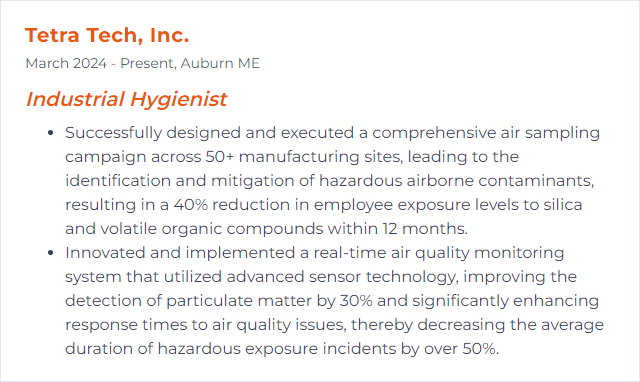
2. Noise Monitoring
Noise monitoring involves measuring sound levels and personal noise exposure to evaluate risk, confirm controls, and protect hearing.
Why It's Important
Unchecked noise steals hearing slowly and silently. Monitoring reveals who’s at risk, when peaks occur, and which controls actually work.
How to Improve Noise Monitoring Skills
Use compliant instruments: Select dosimeters and sound level meters that meet relevant ANSI/IEC standards. Verify calibration before and after use.
Measure what matters: Configure exchange rate, threshold, time weighting, and A/C/Z weighting appropriately. Capture full-shift exposures and noisy tasks.
Go beyond a single number: Add octave-band or 1/3-octave analysis to target engineering controls and hearing protector attenuation.
Map the soundscape: Create noise maps to surface hotspots, routes, and temporal patterns.
Close the loop: Pair measurements with controls—enclosures, damping, maintenance, process changes—and verify effectiveness post-implementation.
Support hearing conservation: Integrate training, fit-checked protectors, and audiometric surveillance.
How to Display Noise Monitoring Skills on Your Resume
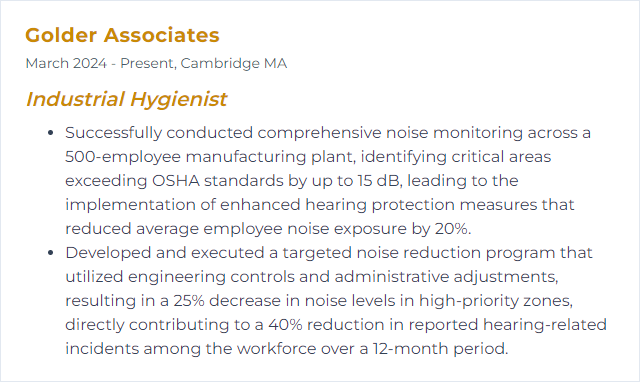
3. Ventilation Assessment
Ventilation assessment examines whether general and local exhaust systems capture and remove airborne contaminants effectively, maintaining healthy indoor air.
Why It's Important
Without effective capture, contaminants linger, spread, and accumulate. Ventilation is often the difference between control and exposure.
How to Improve Ventilation Assessment Skills
Map the system: Document air inlets, exhausts, hoods, air handlers, and airflow paths. Note pressure relationships between rooms.
Measure, don’t guess: Use anemometers, pitot tubes, and manometers to quantify capture velocity, duct velocity, static pressure, and airflow balance.
Visualize capture: Use smoke or tracer methods to confirm hood capture and air movement, especially at sources and worker breathing zones.
Check effectiveness: Pair air quality indicators (e.g., CO2 for occupancy-driven ventilation) and contaminant measurements with system performance.
Tune and maintain: Verify hood design and placement, repair leaks, clean filters, set proper MERV/HEPA ratings, and rebalance when processes change.
Prioritize local exhaust: Control at the source with well-designed LEV; use general ventilation to dilute residuals, not as a primary fix for point sources.
Educate users: Train operators to position work and adjust baffles/sashes to preserve capture.
How to Display Ventilation Assessment Skills on Your Resume
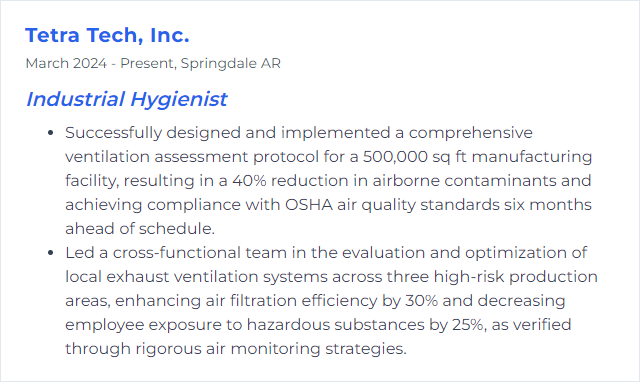
4. Hazard Communication
Hazard Communication (HazCom) ensures chemical hazards are identified, labeled, documented, and clearly explained to workers through SDS, training, and consistent procedures.
Why It's Important
People can’t protect against what they don’t understand. Clear, consistent communication turns hazards into managed risks.
How to Improve Hazard Communication Skills
Keep a living inventory: Track every chemical and process-generated byproduct; review regularly.
Control your SDS: Maintain current, accessible Safety Data Sheets. Train on the sections that matter for day-to-day work.
Label with purpose: Use GHS-consistent labels, secondary container rules, and workplace-specific messaging where needed.
Train for retention: Make training practical—real tasks, real labels, real SDS exercises—and refresh at meaningful intervals.
Plan for emergencies: Post procedures for spills, exposures, and first aid. Drill them.
Audit and improve: Inspect storage, labeling, and SDS access. Fix gaps quickly and visibly.
How to Display Hazard Communication Skills on Your Resume
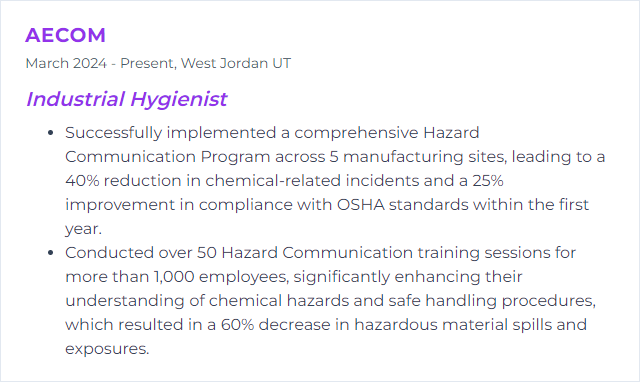
5. Ergonomics Evaluation
Ergonomics evaluation analyzes tasks, tools, and workstations to reduce strain and prevent musculoskeletal disorders while supporting performance.
Why It's Important
Thoughtful design trims fatigue and injury, boosts quality, and keeps people working comfortably, longer.
How to Improve Ergonomics Evaluation Skills
Observe the work: Watch tasks at normal and peak pace. Capture reach, force, posture, repetition, and duration.
Use the right tools: Apply REBA/RULA, the NIOSH Lifting Equation, and task-specific checklists. Measure where judgment gets fuzzy.
Ask and listen: Use discomfort surveys and worker interviews to surface hidden pain points.
Design practical fixes: Adjustable heights, tool balancing, neutral postures, microbreaks, job rotation, carts instead of carries.
Make it participatory: Involve employees in trials and selection of controls; refine with their feedback.
Track outcomes: Monitor symptoms, quality metrics, and productivity before and after changes.
How to Display Ergonomics Evaluation Skills on Your Resume
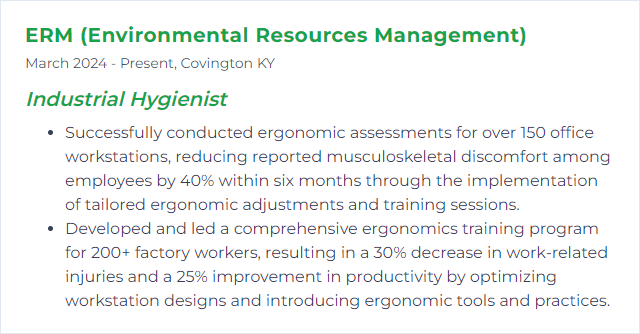
6. Chemical Analysis
Chemical analysis identifies and quantifies hazardous substances from air, surface, bulk, or biological samples to inform exposure decisions and controls.
Why It's Important
When numbers matter, accuracy matters more. Reliable analytics separate real risk from noise.
How to Improve Chemical Analysis Skills
Use validated methods: Select methods matched to analyte, matrix, and required sensitivity; confirm LOD/LOQ and interferences.
Control the chain: Preserve sample integrity with correct media, preservation, transport, and airtight chain-of-custody.
Mind the instruments: Keep GC-MS, HPLC, ICP-MS, and other systems calibrated, maintained, and checked with standards.
Build QC into every batch: Blanks, duplicates, spikes, and control charts; review recoveries and flags critically.
Select accredited labs: Prefer accredited labs with demonstrated proficiency in the target methods.
Interpret with context: Pair lab results with process knowledge, sampling uncertainty, and applicable OELs.
How to Display Chemical Analysis Skills on Your Resume
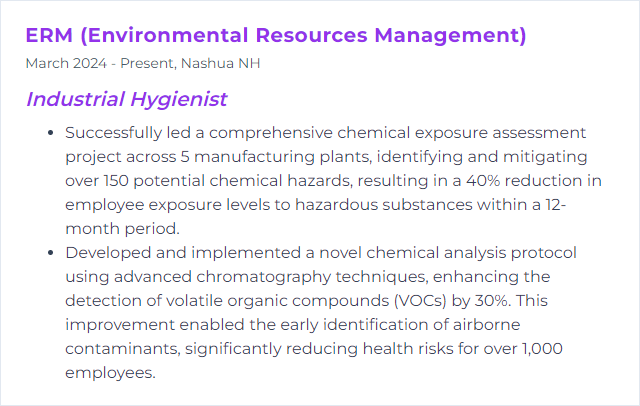
7. IH Data Interpretation
IH data interpretation turns measurements into decisions—analyzing patterns, estimating risk, and determining whether controls or more monitoring are needed.
Why It's Important
Good data can mislead if poorly interpreted. Sound interpretation guides resources to the right problems at the right time.
How to Improve IH Data Interpretation Skills
Strengthen statistics: Understand lognormal distributions, percentiles, confidence bounds, exceedance fractions, and decision limits.
Group exposures smartly: Build defensible similar exposure groups (SEGs) and verify with data.
Use appropriate tools: Apply exposure decision frameworks and, when suitable, Bayesian approaches to small datasets.
Interrogate the outliers: Check for data entry errors, method changes, seasonal effects, and process upsets before concluding.
Visualize generously: Time series, box plots, and heat maps often reveal what tables hide.
Document assumptions: State what you assumed about tasks, controls, and variability so conclusions can be revisited as conditions change.
How to Display IH Data Interpretation Skills on Your Resume
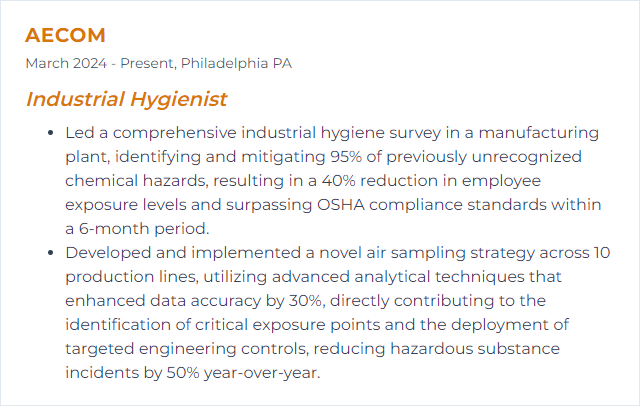
8. PPE Selection
PPE selection means choosing protective equipment that truly matches hazards, tasks, and users—without creating new risks.
Why It's Important
When higher-level controls aren’t enough, PPE stands between workers and harm. The wrong choice can give a false sense of safety.
How to Improve PPE Selection Skills
Start with the hazard: Define agents, concentrations, physical form, routes, and duration. Select PPE only after engineering and administrative options are addressed.
Match standards: Align with relevant specifications (e.g., ANSI Z87.1 eye/face, ANSI Z89.1 head, ASTM F2413 foot, ANSI/ISEA 105 hand).
Choose respiratory protection wisely: Use NIOSH-approved respirators, apply assigned protection factors, and conduct fit testing. Build a full respiratory protection program when required.
Prioritize comfort and compatibility: Check for heat stress, mobility constraints, and interactions among PPE types.
Train, maintain, replace: Teach correct donning/doffing, cleaning, limits, and storage. Replace on schedule or when damaged.
Close feedback loops: Gather worker input and field performance data; refine selections accordingly.
How to Display PPE Selection Skills on Your Resume
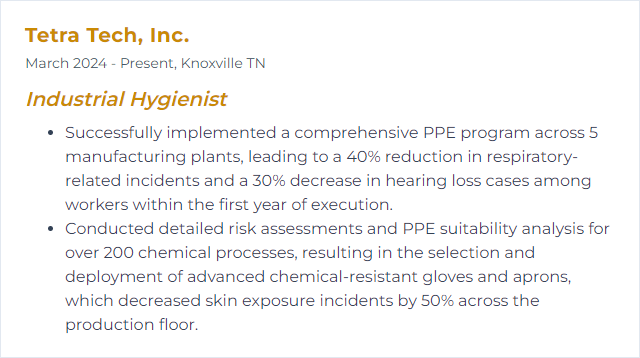
9. Risk Assessment
Risk assessment identifies hazards, estimates the likelihood and severity of harm, and sets control priorities to reduce risk to acceptable levels.
Why It's Important
It turns scattered concerns into a ranked action list. That clarity saves time, money, and health.
How to Improve Risk Assessment Skills
Cast a wide net: Combine walkthroughs, interviews, SDS reviews, incident data, and change management inputs to spot hazards.
Score consistently: Use a defined matrix for consequence and likelihood; include exposure frequency and existing controls.
Apply the hierarchy of controls: Favor elimination, substitution, and engineering controls before admin measures and PPE.
Validate and verify: After controls, reassess residual risk with measurements or observations.
Make it living: Update assessments after incidents, new processes, or staffing/production changes.
Track leading indicators: Maintenance defects, near misses, and permit deviations often predict trouble before injuries appear.
How to Display Risk Assessment Skills on Your Resume

10. IH Software (e.g., IH Mod)
IH software supports exposure assessment, modeling, data management, and reporting—streamlining complex evaluations and improving consistency.
Why It's Important
Well-used tools speed analysis, reveal patterns, and preserve a clean audit trail. They help you answer tough questions faster.
How to Improve IH Software (e.g., IH Mod) Skills
Learn the assumptions: Understand model foundations (e.g., well-mixed room, near-field/far-field) and when they don’t apply.
Validate with reality: Compare modeled outputs to measured data; recalibrate inputs as you learn.
Keep data tidy: Standardize units, naming, and metadata. Use templates for SEGs, tasks, and OELs.
Document decisions: Save versions, note assumptions, and export clear reports with inputs, limits, and results.
Run scenarios: Model control options and what-if cases to prioritize interventions.
Protect information: Manage permissions and safeguard sensitive health and operational data.
How to Display IH Software (e.g., IH Mod) Skills on Your Resume
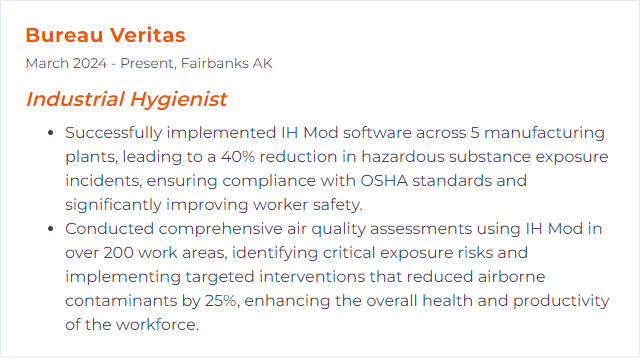
11. Biohazard Management
Biohazard management controls risks from biological agents through engineering, administrative measures, PPE, hygiene, waste handling, and emergency response.
Why It's Important
Biological exposures can cascade quickly. Strong controls protect workers, the community, and the environment.
How to Improve Biohazard Management Skills
Assess and classify: Identify agents, exposure routes, and required biosafety level; maintain an exposure control plan.
Engineer the barriers: Use biosafety cabinets, directional airflow, proper filtration, and secure storage.
Hygiene and PPE: Emphasize hand hygiene, appropriate PPE selection, and correct donning/doffing.
Decontamination and disinfection: Select agents effective for the organism and surface; verify contact times and procedures.
Waste and transport: Segregate, package, label, and dispose of biohazardous waste according to requirements; train staff thoroughly.
Medical surveillance: Vaccinations, exposure response, and follow-up protocols tailored to the risk.
Drill the response: Spill kits, exposure reporting, and emergency communication practiced, not just written.
How to Display Biohazard Management Skills on Your Resume

12. Regulatory Compliance
Regulatory compliance means aligning policies, practices, and records with applicable health and safety laws and standards.
Why It's Important
Compliance protects workers and the organization—preventing harm, penalties, and operational disruption.
How to Improve Regulatory Compliance Skills
Know what applies: Build a register of federal, state, and local requirements relevant to your operations; review it routinely.
Operationalize requirements: Translate rules into clear SOPs, checklists, and training that people can actually follow.
Train with intent: Maintain a training matrix, refresh at defined intervals, and verify competency.
Audit and correct: Conduct internal audits, track findings to closure, and verify effectiveness of corrective actions.
Document like it matters: Keep thorough records—exposure data, permits, inspections, incidents, and actions—organized and retrievable.
Manage change: Reassess compliance when processes, materials, or equipment change; involve stakeholders early.
How to Display Regulatory Compliance Skills on Your Resume

